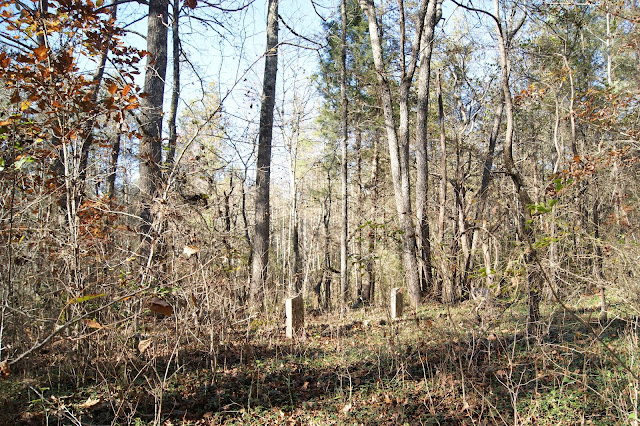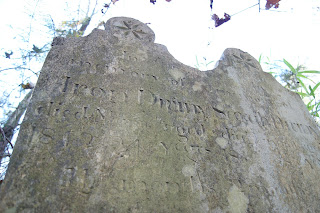I hope you are all well. I wanted to share with you an interesting story and a small adventure just north of King's Mountain. The story about Ferguson is in the first few paragraphs, as shared by my mother. The story to follow is of me trying to find the sites.
There is an old cemetery in the backwoods of Rutherford County, formerly Tryon County. There are many stories to relate surrounding the colonists of the area and the Revolutionary War, but I don't think this one has made most histories that can commonly be found in a library.
The major characters:
Sarah Deveny (Diviny, Deviney ,Devinney, Deveny) - formerly Sarah Black. Born in 1748 in York , PA, probably an Ulster Scot, our grandmother. Wife of Aaron Deveny.
Aaron Deveny - Tryon County partisan / patriot. Militia captain. Grandfather. Neighbor of John Walker (grandfather, signer of the Tryon Resolves, Major 1st NC Regiment Continental Line, friend of Daniel Boone, father of Felix Walker) and Aaron Biggerstaff (prominent loyalist).
Major Patrick Ferguson - British army, 71st Foot. Scottish commander of a Provincial Corps (tories) in North Carolina in 1780 until he threatened local rebels that he would "lay waste to their country with fire and sword."
James McFarland - early settler of Fourth Creek Congregation, Rowan County (now Iredell Co). Grandfather.
Aaron Biggerstaff - Loyalist. Died of wounds from King's Mountain. 9 loyalists hung on his land "Red Chimneys"
To weave together a few of the above men and their connections and to recognize what happened later, some of which will be covered in a separate post, such as the loyalist story:
Tryon County North Carolina Court Minutes -
P 221 – April 1774 - Ordered by the court that Alexander McGaughey....Aaron
Biggerstaff, Aaron Deviny .... serve as jurors to
lay out a road from John Walkers, Esq-r on Second Broad River nearby Thomas
Welch’s and from thence the
nearest and best way to the province line.
And bearing a direct course to Charles Town..
The story first, as told in our family and in the pension application:
Aaron moved his family to Tryon (now Rutherford) Co. North Carolina in 1772. In 1775 he was commissioned a Lieutenant by Col. William Graham and assigned to Capt. Robert Rankins Co. of the Tryon Militia. Throughout the fall and winter of 1775-76, the company was sent out on scouting parties, protecting the frontier settlements from Indian attacks and raids by Tories. In 1776, his home was plundered and burned by Tories. In 1777 he was ordered to take charge of the fort at Montford's Cove. When Capt. Rankins left the county, Aaron was elected Captain by his company, and later commissioned to that rank by Col. Andrew Hampton. He was ordered to bring his Company to Gilbert Town, where Tories were causing trouble. They were successful in capturing several Tory prisoners, including their Captain. While the Tory captain's name is not listed, the record does state that he was later hung.
In 1780, Aaron was ordered by Col. McDowell and Col. Hampton to bring his Company to the South Fork of the Catawba, where they were placed under the command of General Griffith Rutherford, and participated in the Battle of Ramsour's Mill. Shortly after that battle, Aaron's company was ordered to the head of Cane Creek to intercept British Major Ferguson's troops. Aaron started out to contact and warn the Burke Co. militia, and in the process was captured by three of Ferguson's spies. He was held prisoner 13-14 days, during which time his wife Sarah pleaded with Col. Ferguson to release her husband. When she eventually resorted to tears, Ferguson gave in, exclaiming that he "had rather see 20 dead men than one woman in tears." Aaron and some other captured patriots were paroled after taking an oath not to again take up arms against Britain. While some of those paroled later pursued Col. Ferguson to King's Mountain (where he was killed in battle), Aaron kept his oath and returned home, where he was put in charge of the fort at Montford's Cove and McGaugheys fort to defend against Indians.
So I knew that Aaron and Sarah Deviney's headstones still exist in the Rutherford County North Carolina woods near South Mountains State Park. The cemetery has long been grown over and is not on a major road. I plotted my route there with satellite imagery and some directions from a book written in the 60s or 70s. Those were conveyed to me by my mother, who had been there in the late 1970's.
I indeed had some trouble finding the cemetery. I went to the area of Laurel Hill and turned west not too far from there and there was a fender bender, a minor car wreck, on the road to Casar. I slowed up, but the firetruck was already present and it didn't look serious. More on that later.
Proceeding into Cleveland county, I was now just south of South Mountains State Park and Game Lands. I crossed into Rutherford County out in the country. It is very hilly with many creeks and rivers, as our land deeds and descriptions would indicate is the case for this area of North Carolina.
I tried to follow the directions near the Broad River, but they didn't completely add up. There was no road to match what was on the directions from the 70s. I decided I needed to stick to the main road and think it over before diving into the woods. Mom had warned me of the amount of briars and undergrowth in the area and how many times it took her to find the cemetery in 1979.
I had come through Casar and decided to double back a bit. I stopped beside an AT&T truck because, I don't know, I thought maybe he'd know the area. As I pulled over, across the street, there was a brick building, probably from the 1930's, with a small sign that said "Deviney Lumber". At that point, I knew I was getting warm.
I walked inside and it really wasn't a lumber yard, but rather just some offices in an old building. There was only one woman there. I explained who I was and what I was looking for. She said her husband was a Deviney and had just stepped out to go to a car wreck of her sister in law. As it turns out, I'd seen a Deviney cousin's car wreck. I told her I didn't think it serious. It turns out she knew right where the cemetery was, but she first asked me if I was looking for the cemetery "by the church", to which I replied, "No, it is in the woods."
She told me, "There are bears down there." I actually thought she said barriers. I was more worried about getting shot than a black bear I suppose. She said the bears and the copperheads were taking over and that it was a long walk through the woods. I drove down the road to where I thought I should park, then began hiking. It was a beautiful creek, as you can see from the pictures. I haven't been in a place that peaceful in a while, so the dog and I made the most of the hike.
I stuck close to the creek, as I was afraid erosion might have changed things, and I hoped to be able to see the headstones from the creek itself. I hacked my way along the bank for a long way and came eventually to a 30 foot embankment. I climbed that and, sweaty and dirty, began to doubt myself. I ended up behind a shanty of a cabin with some beat up furniture along the creek. I felt a little insecure, so decided to head back, knowing the cemetery could be 50 yards to either side of me, and that I might walk right by it.
My next thought was that of old roads. Supposedly the cemetery was along an old road "crossing the new road". I backed off the creek and decided to concentrate on finding a road. The terrain I had traversed thus far wasn't such.
Shortly after doubling back, I saw that our Lab was following a flat path through the woods, with a slope above us on the right and on our left a slope leading to the creek bank. I was sure it was the old road. Sure enough, I paused for a moment to take it all in and, at that point, I saw a Civil War marker.
The dog finds the road
The road looking west
The road
First glimpse
There are only two Civil War markers there and they are not the predominant type of headstones. Rather, the cemetery is mainly McFarlands, as detailed previously, and Aaron and Sarah Deviney (Diviny), accompanied by I'd guess 30 rock markers that are unidentifiable.
The McFarlands pictured here are descendents of James (Jas) McFarland of Fourth Creek Congregation, which was an early Scots Irish settlement in Rowan County (now Iredell), who is a grandfather. If you have been to Fort Dobbs, there is a map of Fourth Creek Settlement on the wall there. Jas McFarland is at the upper left of the map (the map isn't north on the top, incidentally). A full resolution map is here:http://dc.lib.unc.edu/cdm/ref/collection/ncmaps/id/118
 |
Aaron and Sarah Deveny
(grandparents)
James McFarland appears in North Carolina about 1768 and these are his children and grandchildren. Aaron Deveny and John McFarland, whose headstones are pictured, are our grandfathers.
John McFarland (grandfather)
Patrick
Sarah McFarland
Sarah McFarland
William, grandson of James of Fourth Creek Congregation.
Next up: Loyalist hangings and James Dunlap
Enjoy the photos. You can really get immersed if you ever go there.
Scott






















